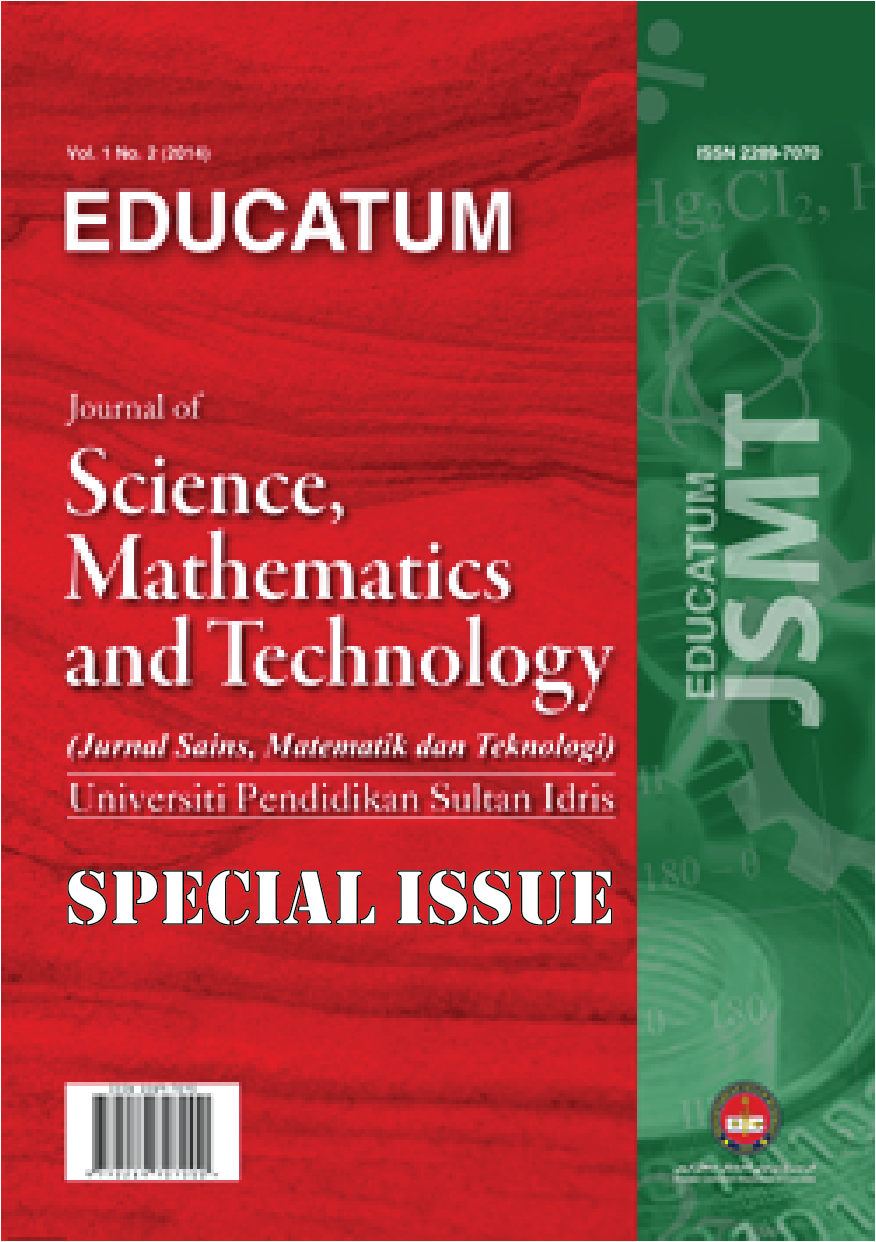The Development of an Android Application of Terms Register in Malay – English for KSSM Physics and Its Usability among Student Teachers
DOI:
https://doi.org/10.37134/ejsmt.vol9.sp.4.2022Keywords:
Translation, Android, KSSMAbstract
This research aims to develop an Android application of terms register in Malay – English for KSSM Physics for Physics student teachers’ use. A need analysis was performed to obtain feedback from ten student teachers about the existence of this application. This application is developed based on the ADDIE instructional model and undergoes a pilot test using a qualitative approach to obtain the initial feedback. After improvement, this application undergoes an application validity process through three experts using face and content validity forms. A quantitative approach was made using the Heuristic Evaluation Questionnaire (HEQ) survey on 30 student teachers to obtain the application usability. This research has produced an application on an Android platform containing 418 extracted terms from Standard Document for Curriculum and Assessment (DSKP) for Form 4 and Form 5 Physics with the application name is FiPhyNeo. FiPhyNeo receives a Content Validity Index (CVI) of 0.93. FiPhyNeo also has obtained high usability (mean = 4.37 ± 0.34). This research developed an Android application called FiPhyNeo containing terms register in Malay – English for KSSM Physics for student teachers that is valid with high usability. This research will benefit the student teachers, current teachers, and students for a fast and easy search of terms register and operates in offline mode to support the teaching and learning of Physics.
Downloads
References
Md Yunus, M., & Sukri, S. I. A. (2017). The Use of English in Teaching Mathematics and Science: The PPSMI Policy vis-à-vis the DLP. Advances in Language and Literary Studies, 8(1), 133-142. https://doi.org/10.7575/aiac.alls.v.8n.1p.133
Besar, J. A., & Jali, M. F. M. (2010). Pemansuhan Dasar PPSMI: Tinjauan daripada Persepsi Parti Politik, Ahli Akademik dan NGO serta Pengalaman di Sekolah. Jurnal Melayu, 5.
Ahmad, R. @ R., Majid, N., Mamat, N. J. Z., Rambely, A. S., Muda, N., Jaaman, S. H. H., Suradi, N. R. M., Ismail, W. R., Shahabuddin, F. A., Nazar, R. M., Samsudin, H. B., Zin, W. Z. W., Zahari, M., & Rafee, N. M. (2012). Transformation of Language in Teaching and Learning Policy. Procedia - Social and Behavioral Sciences, 59, 685-691. https://doi.org/10.1016/j.sbspro.2012.09.331
Bullah, N. H., & Yunus, M. M. (2019). Teachers’ perception on the implementation of Dual Language Programme (DLP) in urban schools. Asian Social Science, 15(1), 24-31. https://doi.org/10.5539/ass.v15n1p24
Suliman, A., Mohd Nor, M. Y., & Md Yunus, M. (2020). Dual-Language Programme (DLP) Implementation in Malaysian Secondary Schools: from the Lenses of School Administrators (Implementasi Program Dual-Language (DLP) di Sekolah Menengah Malaysia: Dari Lensa Pentadbir Sekolah). Jurnal Pendidikan Malaysia (Malaysian Journal of Education), 45(1SI), 60-67. https://doi.org/10.17576/jpen-2020-45.01si-08
Suliman, A., Nor, M. Y. M., & Yunus, M. M. (2020). Illuminating students’ understanding and acceptance towards the dual language programme (DLP). Cakrawala Pendidikan, 39(3), 522–531. https://doi.org/10.21831/cp.v39i3.30760
Ismail, A. T., & Ayop, S. K. (2016). Tahap Kefahaman Dan Salah Konsep Terhadap Konsep Daya Dan Gerakan Dalam Kalangan Pelajar Tingkatan Empat. Jurnal Fizik Malaysia, 37(1), 01090–01101.
Ghani, M. A., & Ayop, S. K. (2018). Validity and Reliability of Conceptual Survey in Electricity and Magnetism ( CSEM ) Instrument in Malay. International Journal of Academic Research in Business and Social Sciences, 8(7), 595–606. https://doi.org/10.6007/IJARBSS/v8-i7/4402
Jamel, F. M., Ali, M. N., & Ahmad, N. J. (2019). The needs analysis in game-based STEM module development for KSSM science teachers. International Journal of Recent Technology and Engineering, 8(3), 6622-6628. https://doi.org/10.35940/ijrte.C5655.098319
Harun, M. T., & Yaacob, M. I. H. (2015). Penilaian kualiti modul FZ-STEM: aspek kesahan dan kebolehpercayaan. Journal of Quality Measurement and Analysis, 11(2), 1–10.
Kementerian Pendidikan Malaysia. (2016). Buku Penerangan Kurikulum Standard Sekolah Menengah (KSSM). E-conversion - Proposal for a Cluster of Excellence.
Yusuf, N. M., Abd Rahman, N., & Ghazali, N. (2021). The Effect of a Technology-Enhanced Learning (TEL) Module on the Achievement of Form Four Students in the Topic of Waves and Sound. Jurnal Pendidikan Sains Dan Matematik Malaysia, 11, 81-93. https://doi.org/10.37134/jpsmm.vol11.sp.8.2021
Mahad, I., Magesvaran, U., & Hamzah, I. N. S. (2021). Sikap Dan Motivasi Murid Sekolah Rendah Terhadap Pembelajaran Bahasa Melayu Dalam Talian Sepanjang Perintah Kawalan Pergerakan, Jurnal Pendidikan Bahasa Melayu, 11(1), 16-28.
Agus, A. N. A. (2021). Tahap Pengetahuan Dan Kesediaan Guru Bahasa Melayu Dalam Melaksanakan Pendekatan Terbeza Dalam Pengajaran Dan Pembelajaran Di Rumah Semasa Tempoh Perintah Kawalan Pergerakan. Jurnal Pendidikan Bahasa Melayu, 11(1), 75-87.
Bernama. (2020, November). COVID-19: Pendidikan menerusi dunia maya cabaran baharu buat guru. Berita Harian. https://www.bharian.com.my/berita/nasional/2020/05/689322/covid-19-pendidikan-menerusi-dunia-maya-cabaran-baharu-buat-guru
Ibrahim, H., & Hamid, A.A. (2020). Kelas online: 36.9 peratus murid tak ada peranti. Harian Metro. https://www.hmetro.com.my/mutakhir/2020/07/602634/kelas-online-369-peratus-murid-tak-ada-peranti
Berita Harian. (2021). Tiada capaian internet, gajet seperti belajar di sekolah daif. Berita Harian. https://www.bharian.com.my/berita/nasional/2021/01/779410/tiada-capaian-internet-gajet-seperti-belajar-di-sekolah-daif
Khalid, N., Jaafar, H., & Kasbun, R. (2015). Developing a Mobile Learning Application Framework of “Jamak Qasar Apps” using ADDIE Approach. Australian Journal of Basic and Applied Sciences, 9(19), 40-44.
Bahagian Pembangunan Kurikulum. (2018). DSKP KSSM Fizik Tingkatan 4 dan 5. Kementerian Pendidikan Malaysia. https://doi.org/10.3991/ijim.v12i2.8014
Ariffin, S. A., Ismail, A., Yatim, M. H., & Sidek, S. F. (2018). An assessment of culturally appropriate design: A Malaysian university context. International Journal of Interactive Mobile Technologies, 12(2), 207–214. https://doi.org/10.3991/ijim.v12i2.8014
Md Yusoff, H., Hamzah, M. I., & Surat, S. (2018). Kesahan dan Kebolehpercayaan Instrumen Indeks Pemupukan Kreativiti dalam Pengajaran Guru dengan Elemen Islam (I-CFTI) Berdasarkan Pendekatan Model Rasch (Validity and Reliability of Creativity Fostering Index Instrument in Teacher Instruction with Islamic). Jurnal Pendidikan Malaysia, 43(03), 77–88. https://doi.org/10.17576/jpen-2018-43.03-09
Madihie, A., & Noah, S. M. (2013). An application of the Sidek Module Development in REBT counseling intervention module design for orphans. Procedia-Social and Behavioral Sciences, 84, 1481-1491. https://doi.org/10.1016/j.sbspro.2013.06.777
Ali, M. F. Bin, Ahmad, A. R., & Seman, A. A. (2017). Teachers’ Competencies in Teaching and Learning History. Open Journal of Social Sciences, 05(08), 220. https://doi.org/10.4236/jss.2017.58018





